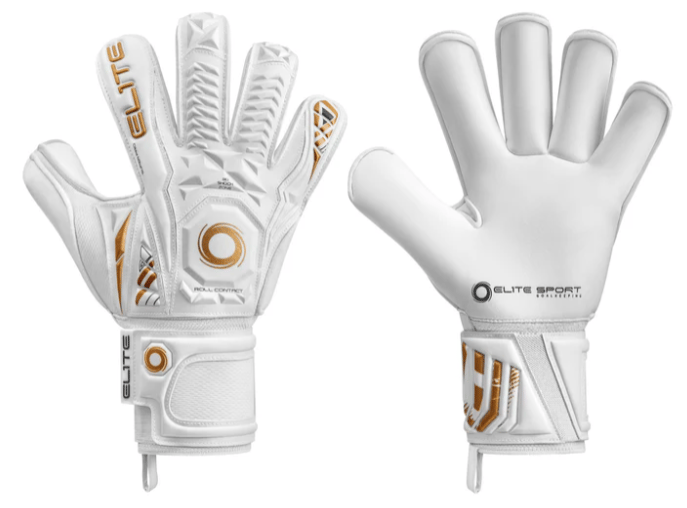- Elite Keepers Shop
- Posts
- Importance of Grip: Understanding Palm Materials in Soccer Gloves
Importance of Grip: Understanding Palm Materials in Soccer Gloves
Soccer gloves are essential for goalkeepers, providing not only protection but also enhancing performance on the field. One of the most important aspects of a goalkeeper's gloves is the material used in the palm. The grip of a glove determines how well a goalkeeper can catch, hold, and throw the ball, making it a crucial factor in their overall performance. In this blog, we'll dive into the significance of grip in soccer gloves, with a focus on the materials used in the palm, how they affect performance, and how to choose the right pair for different conditions.
The Role of Grip in Soccer Gloves
A goalkeeper’s primary job is to stop the ball, and their gloves play a vital role in this process. The grip of a soccer glove directly influences how secure the ball feels when it makes contact with the palm. Without a good grip, even the most skilled goalkeeper can struggle to maintain control of the ball, especially in challenging weather conditions like rain or snow.
Grip is vital in enabling goalkeepers to catch the ball cleanly and securely. It can also help in making powerful throws and releasing the ball effectively. When goalkeepers face powerful shots or high-speed crosses, the grip of the glove provides the necessary control to handle those situations.
Palm Material and Its Influence on Grip
The material used in the palm of soccer gloves is a key factor in the level of grip they provide. There are several different types of palm materials, each offering a unique balance of grip, durability, and performance in varying conditions. Let's take a look at the most common materials used and how they affect grip:
1. Latex Palm
Latex is the most commonly used material in high-performance soccer gloves. It is known for its superior grip and cushioning properties, making it ideal for wet or dry conditions. Latex provides excellent ball control, allowing goalkeepers to catch the ball with ease. However, latex palms are more prone to wear and tear compared to other materials, particularly on abrasive surfaces like artificial turf.
There are different types of latex used in soccer gloves, including:
Soft latex: Known for its exceptional grip, especially in dry conditions. It's often used by professional goalkeepers who prioritize performance over durability.
Negative latex: Offers a balance of grip and durability, making it suitable for various weather conditions.
Contact latex: Known for its high-quality grip, making it ideal for high-level performance in dry conditions.

2. Synthetic Palm
Synthetic palm materials are often used in gloves designed for durability and all-weather performance. These palms tend to be less grippy than latex but offer greater longevity. Synthetic materials are more resistant to abrasions and are often favored by goalkeepers who play in rough conditions or on artificial surfaces. While they may not provide the same level of grip as latex, synthetic palms are more reliable in wet or muddy conditions.
Choosing the Right Palm Material
When selecting gloves, goalkeepers must consider several factors, including the playing environment, frequency of use, and personal preference. Different palm materials offer unique benefits and drawbacks, so understanding their characteristics is essential to making an informed choice.
Weather Conditions
Wet Conditions: Latex gloves perform best in wet conditions as they offer superior grip when damp. However, if a goalkeeper frequently plays in heavy rain, they may need to focus on gloves that have a specialized wet-weather latex, which can maintain its grip in such conditions.
Dry Conditions: Synthetic palms tend to perform better in dry conditions, offering good durability while providing enough grip. For goalkeepers who play in dry climates or on artificial turf, synthetic palms can be a great option.
Durability vs. Performance
Performance-Oriented Gloves: If performance is the priority, latex palms are often the best choice due to their superior grip and ball control. However, latex gloves require more care and may not last as long as synthetic gloves.
Durable Gloves: For goalkeepers who need gloves that can withstand frequent use without losing their grip, synthetic palms are more durable and can handle rough conditions without significant wear and tear.
Caring for Palm Materials
Proper care of soccer gloves can help preserve the palm material and maintain its grip for a longer period. Here are a few tips for maintaining your gloves:
Clean Regularly: After each use, clean your gloves with lukewarm water to remove dirt and debris. Avoid using harsh detergents or hot water, as this can damage the palm material.
Store Properly: Always store your gloves in a cool, dry place to prevent the palm material from deteriorating. Avoid leaving them in direct sunlight, as this can dry out the latex.
Avoid Overuse: Overusing gloves in harsh conditions, such as playing on artificial turf or in wet weather, can reduce the lifespan of the palm. Rotate between multiple pairs of gloves to prevent excessive wear on a single pair.
Rehydrate Latex Gloves: For latex palms, some goalkeepers use specific glove sprays or conditioners to keep the latex hydrated, which helps maintain grip and prevent cracking.
The grip of soccer gloves plays a pivotal role in a goalkeeper's ability to perform at their best. By understanding the different materials used in the palm and how they affect grip, goalkeepers can make more informed decisions about which gloves are best suited to their needs. Whether you prioritize grip, durability, or all-weather performance, the right palm material can enhance your performance on the field. With proper care, your gloves will provide the control and security you need to make crucial saves and support your team to victory.